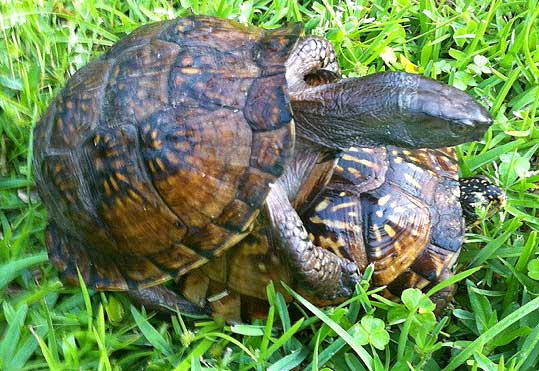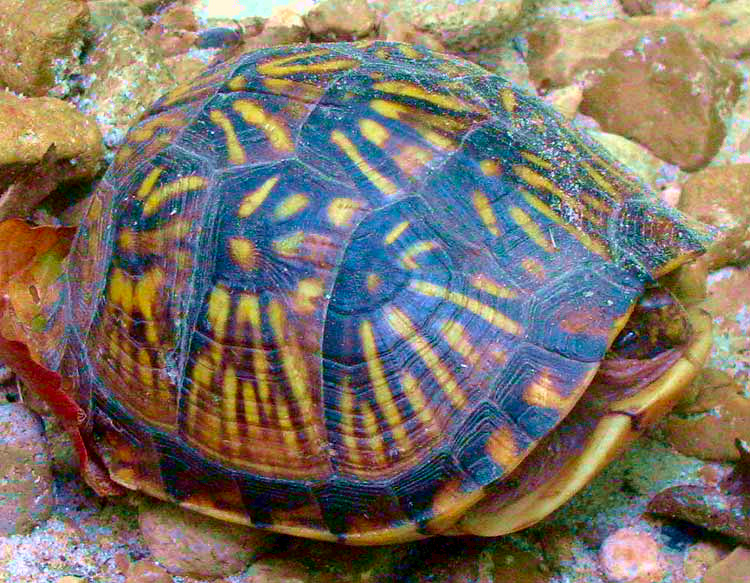Excerpts from Jim Conrad's
Naturalist Newsletter
from the April 29, 2012 Newsletter issued from the woods of the Loess Hill Region a few miles east of Natchez, Mississippi, USA
MATING BOX TURTLES
Hillary on the Mississippi Gulf Coast sent us a picture of two Box Turtles, TERRAPENE CAROLINA, mating in his backyard, shown below.

It's interesting to see how turtles manage it, but for many readers familiar with box turtles in other parts of North America the picture may raise the question of why those in our picture bear different colors and patterns than theirs. What's happening is that Box Turtles are represented by six intergrading subspecies.
Hillary's Gulf Coast location is supposed to be home to the Gulf Coast subspecies, Terrapene carolina ssp. major. However, that subspecies is described as having a brownish top shell, or carapace, sometimes with a few dull spots or rays, but nothing like these bright, yellow lines. I can't say what's going on. Apparently Box Turtle taxonomy is a bit tricky.
from the April 28, 2002 Newsletter issued from the woods of the Loess Hill Region a few miles south of Natchez, Mississippi; elevation ~200ft (~60m), ~N31.42°, ~W91.41°; USA
WANDERING BOX TURTLES
Box Turtles are wandering the forest these days. One day this week I saw two, though often entire weeks and months pass without my seeing one. This morning, Sunday, I needed to bike to town for supplies and I saw three in different places beside US 61's pavement. When I was a child on the farm in Kentucky they were common there, but now they are rare. I am glad when I see them now, for their populations have plummeted everywhere.
Box Turtles are TERRAPENE CAROLINA, so are they properly called terrapins? Well, not really. They're "dry-land turtles." If you want to nail down the differences between turtles, tortoises and terrapins, I explain it on the Web at www.backyardnature.net/turtles.htm
The box turtles here don't look like the ones I knew in Kentucky. Up there their shells are patterned brightly with yellow and black. The ones down here bear olive-colored shells with hardly any pattern at all. The deal is that the species is fracturing into different, sometimes intergrading subspecies. Ours comes closest to being the Three-toed subspecies, Terrapene carolina triunguis.
Whatever name they go by, there's just something good about seeing a clunky-looking old box turtle gamely clambering across the forest floor.
from the May 11, 2003 Newsletter issued from the woods of the Loess Hill Region a few miles south of Natchez, Mississippi; elevation ~200ft (~60m), ~N31.42°, ~W91.41°; USA
THREE-TOED BOX TURTLE
I didn't get far before I found a Three-toed Box Turtle, TERRAPENE CAROLINA TRIUNGUIS, right in the dusty middle of the trail. Box Turtles are known to have a passion for berries, so maybe he'd been hanging around the Red Mulberry, getting what fell to the ground. Box turtles also eat mushrooms poisonous to man, and I've read that turtle-eating people have died from eating box turtles who had recently dined on the wrong mushroom. This danger didn't keep New York Indians from causing the extinction of this species over large areas because of their passion for turtle meat -- also for their use of the shells as ceremonial rattles.
You might wonder why, of all the turtles available, New York Indians preferred box turtle shells for making rattles. One reason was surely that in New York box turtle shells were beautifully ornate. Much prettier than ours. In fact, the box turtles I grew up with in western Kentucky had the same colorful patterns as the New York Indians' turtles did. Shells of the box turtles we have around Natchez are very drab in comparison.
The deal is that the box turtle known as TERRAPENE CAROLINA is represented by different-looking but interbreeding subspecies. Here are four found in the US:
The Eastern subspecies, which is the New York and Kentucky box turtle, has a brightly ornamented shell and is found from Maine to Georgia, west to Michigan, Illinois and Tennessee. The Gulf Coast one is more drab all over and lives along the coast from western Florida to Louisiana. The Florida subspecies has a brightly patterned shell with radiating lines, and a head with two stripes on it, and is found in lower Florida. Our Three-toed has a drab tan or olive shell but the head and front legs are prettily orange spotted, and it's found from Missouri to Alabama and Texas. The hind legs of the first two subspecies usually bear four toes, but the hind legs of the last two subspecies usually bear only three.
It's good to see how these subspecies blend into one another as one travels across the land. It feels as if we're observing the evolution of the species taking place before our eyes, discovering the species caught in the midst of fracturing into what someday -- if life on Earth survives -- may be four distinct new species with their own sovereign genomes. And one wonders why southern box turtles need only three toes on their hind legs!
from the July 8, 2012 Newsletter issued from the woods of the Loess Hill Region a few miles east of Natchez, Mississippi, USA
BOX TURTLE PUZZLEMENT
The Box Turtle, TERRAPENE CAROLINA, found this week on the dry, sandy floor of a deep, wooded ravine near the trailer was puzzling because he didn't look like the subspecies I'm used to seeing here, and which is supposed to be here. The shells of the ones usually seen here in southwestern Mississippi -- the ones supposed to be here -- are more or less evenly olive-brown. They are known by the name of Three-toed Box Turtle, Terrapene carolina ssp. triunguis. You can see the one found this week peeping from the shell 20 minutes after being disturbed by me below:

In that picture notice how the skin gathers in loose folds around his pulled-in neck, turtleneck style.
However, the top shell, or carapace, of the Three-toed subspecies isn't supposed to be ornamented with such conspicuous yellow rays. That's more typical of the northern subspecies known as the Eastern Box Turtle, Terrepene carolina ssp. carolina.
A while back Hillary on the Mississippi Gulf Coast sent us a picture of two box turtles he said were mating in his yard. {Picture at the top of this page}
Thing is, the literature says that there on the Gulf Coast Hillary is supposed to have the subspecies known as the Gulf Coast Box Turtle, Terrepene carolina ssp. major, whose carapace is brown, very unlike those in Hillary's picture. Hillary's turtle looks just like the one found here this week in our ravine.
UPDATE from 2021: The AnimalDiversityWeb.Org Geographic Range section for Terrapene carolina reports that "Very little overlap occurs between the ranges of the subspecies of Terrapene carolina, except for a region in Mississippi and Alabama where T. c. triunguis and T. c. carolina overlap."